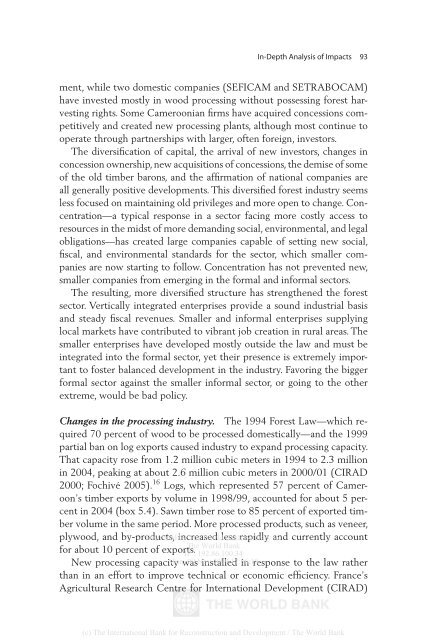The Rainforests of Cameroon - PROFOR
The Rainforests of Cameroon - PROFOR
The Rainforests of Cameroon - PROFOR
- No tags were found...
Create successful ePaper yourself
Turn your PDF publications into a flip-book with our unique Google optimized e-Paper software.
In-Depth Analysis <strong>of</strong> Impacts 93ment, while two domestic companies (SEFICAM and SETRABOCAM)have invested mostly in wood processing without possessing forest harvestingrights. Some <strong>Cameroon</strong>ian firms have acquired concessions competitivelyand created new processing plants, although most continue tooperate through partnerships with larger, <strong>of</strong>ten foreign, investors.<strong>The</strong> diversification <strong>of</strong> capital, the arrival <strong>of</strong> new investors, changes inconcession ownership, new acquisitions <strong>of</strong> concessions, the demise <strong>of</strong> some<strong>of</strong> the old timber barons, and the affirmation <strong>of</strong> national companies areall generally positive developments. This diversified forest industry seemsless focused on maintaining old privileges and more open to change. Concentration—atypical response in a sector facing more costly access toresources in the midst <strong>of</strong> more demanding social, environmental, and legalobligations—has created large companies capable <strong>of</strong> setting new social,fiscal, and environmental standards for the sector, which smaller companiesare now starting to follow. Concentration has not prevented new,smaller companies from emerging in the formal and informal sectors.<strong>The</strong> resulting, more diversified structure has strengthened the forestsector. Vertically integrated enterprises provide a sound industrial basisand steady fiscal revenues. Smaller and informal enterprises supplyinglocal markets have contributed to vibrant job creation in rural areas. <strong>The</strong>smaller enterprises have developed mostly outside the law and must beintegrated into the formal sector, yet their presence is extremely importantto foster balanced development in the industry. Favoring the biggerformal sector against the smaller informal sector, or going to the otherextreme, would be bad policy.Changes in the processing industry. <strong>The</strong> 1994 Forest Law—which required70 percent <strong>of</strong> wood to be processed domestically—and the 1999partial ban on log exports caused industry to expand processing capacity.That capacity rose from 1.2 million cubic meters in 1994 to 2.3 millionin 2004, peaking at about 2.6 million cubic meters in 2000/01 (CIRAD2000; Fochivé 2005). 16 Logs, which represented 57 percent <strong>of</strong> <strong>Cameroon</strong>’stimber exports by volume in 1998/99, accounted for about 5 percentin 2004 (box 5.4). Sawn timber rose to 85 percent <strong>of</strong> exported timbervolume in the same period. More processed products, such as veneer,plywood, and by-products, Delivered increased by <strong>The</strong> World less Bank rapidly e-library and to: currently account<strong>The</strong> World Bankfor about 10 percent <strong>of</strong> exports. IP : 192.86.100.34New processing capacity Mon, was 09 Nov installed 2009 17:06:18 in response to the law ratherthan in an effort to improve technical or economic efficiency. France’sAgricultural Research Centre for International Development (CIRAD)(c) <strong>The</strong> International Bank for Reconstruction and Development / <strong>The</strong> World Bank
















